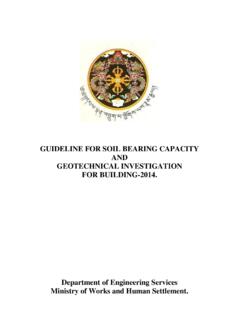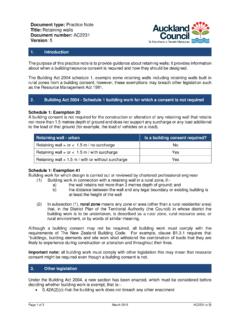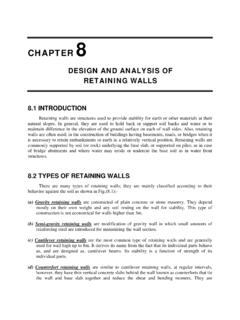Transcription of Stone Retaining Wall Design - mowhs.gov.bt
1 Design and Construction of Stone masonry Retaining walls A Quick Guide i Department of Engineering Services Foreword The Department of Engineering Services is pleased to bring out the Design and Construction of Gravity Stone masonry Retaining walls : A Quick Guide for the benefit of all engineers and builders. Though Stone masonry Retaining walls are simple structures and commonly built in every nook and corner of the country for various earth Retaining purposes, yet many problems are encountered in the field as a result of either improper Design or poor quality constructions. These problems arise mainly due to the fact that engineers in the field are bogged down with numerous responsibilities and often do not find time to carry out proper Design .
2 Also during execution, negligence of some important aspects such as drainage and use of inferior materials add to the issues. This Quick Guide is aimed at providing guidance to designers so that site specific Design calculations can be done. Further standard designs are also provided which can be followed for normal soil conditions. For all important projects, site specific designs should be carried out and the standard designs shall only be used as a reference. I hope this guideline would be of some benefit to all our engineers. Tenzin Director Design and Construction of Stone masonry Retaining walls A Quick Guide ii Department of Engineering Services Table of Contents 1. Introduction .. 1 2. Scope .. 2 3. Typical Failure Modes Of Retaining walls .
3 2 4. Bearing Capacity Of Soil .. 3 5. Design Criteria .. 5 6. Preliminary Design Of Cement masonry walls .. 6 7. Standard Designs .. 8 8. Other Considerations .. 9 DEPTH OF FOUNDATION .. 9 DRAINAGE .. 9 DIP OF FOUNDATION BASE .. 11 LENGTH OF 11 STEPPING OF WALL BASE .. 11 THROUGH-STONES / BONDING ELEMENT .. 12 CEMENT MORTAR .. 13 CURING .. 13 AESTHETICS .. 14 9. Sample Calculations .. 16 10. References .. 22 11. Technical Committee Composition .. 23 Design and Construction of Stone masonry Retaining walls A Quick Guide 1 Department of Engineering Services 1. Introduction Stone masonry Retaining walls are gravity type Retaining walls commonly used to retain earth or fill materials and basically retains earth pressures by virtue of its self-weight.
4 Gravity type Stone masonry Retaining walls are basic and simple structures which are commonly built with locally available stones. It can be built to varying shapes and sizes, provided proper Design procedure is followed. However, beyond 6m height, Stone masonry walls becomes un-economical as it requires large base widths. Most often Retaining walls are designed for static loads and not for seismic forces as it is easier to repair failed walls . In this guideline, standard designs have been provided for static loads only. It is expected to provide quick guidance to engineers in the field both in terms of Design and construction. However, it should be noted that engineers should verify Design based on actual site conditions and the standard designs provided in this guide should be used only as a reference.
5 Further, other considerations such as drainage, foundation requirements, through stones etc. improves the functioning of the wall and appropriate provisions shall be specified in the Design . Design and Construction of Stone masonry Retaining walls A Quick Guide 2 Department of Engineering Services 2. Scope This guideline provides the fundamentals of Design of Stone masonry Retaining walls . The main purpose is to provide standard designs of Stone masonry Retaining wall that can be easily followed by engineers in the field. It should be noted that the standard designs are provided only for heights up to 6m as it becomes uneconomical beyond this height. However, these standard designs should be adopted with caution depending on actual site conditions.
6 For all important projects, engineers are required to carry out site specific Design calculations. 3. Typical Failure Modes of Retaining walls Retaining walls normally fail due to any of the following failure modes. i. Overturning when the overturning moments exceed the resisting moment offered by the components of the wall, it fails due to overturning. ii. Sliding when the frictional resistance offered by the wall components is less than the lateral earth pressure, wall will be moved from its original position and it fails due to sliding. iii. Bearing pressure- when the base pressure exerted, exceeds the safe bearing capacity of the soil, the wall fails due to bearing pressure. Design and Construction of Stone masonry Retaining walls A Quick Guide 3 Department of Engineering Services.
7 Figure 1: Typical Retaining Wall Section 4. Bearing Capacity of Soil The type of soil and its bearing capacity plays a vital role in the stability of the Retaining walls . It is recommended that proper soil tests be carried out before designing of any Retaining wall. However in the absence of soil data for Design , the safe bearing capacity may be assumed as per table 1 of IS 14458 (part 2): 1997 which is given below: Design and Construction of Stone masonry Retaining walls A Quick Guide 4 Department of Engineering Services Table 1: Safe Bearing Capacity of Different Types of Soil Type of Bearing Material Symbol Consistency of place Recommended value of SBC (ton/m2) Well graded mixture of fine and coarse grained soil, glacial till, hard pan, boulder clay GW-GC, GC, SC Very Compact 100 Gravel, gravel-sand mixtures, boulder gravel mixtures GW, GP SW, SP Very compact Medium to compact Loose 80 60 40 Coarse to medium sand, sand with little gravel SW, SP Very compact Medium to compact Loose 40 30 30 Fine to medium sand, silty or clayey medium to coarse sand SW, SM, SC Very compact Medium to compact Loose 30 25 15 Homogeneous inorganic clay, sandy or silty clay CL, CH Very stiff to hard Medium to stiff Soft 40 20 5 Inorganic silt, sandy or clayey silt, varied silt-clay-fine sand ML.
8 MH Very stiff to hard Medium to stiff Soft 30 15 5 Design and Construction of Stone masonry Retaining walls A Quick Guide 5 Department of Engineering Services 5. Design Criteria In Design of Stone masonry Retaining walls , first the anticipated loads on the structure should be considered and then evaluate the safety of the structure based on standard criteria. The loads to be considered in the Design are: Self-weight of the structure; Imposed dead loads and live loads if any; Earth pressures Seismic loads if it is to be designed for earthquakes forces Pore-water pressure Surcharge loads if any Special loads if any The structure then should be evaluated for safety using following criteria: a) Factor of Safety against overturning > for static loads > with seismic forces b) Factor of safety against sliding > for static loads > with seismic forces c) Maximum base pressure qa(allowable bearing capacity) qa(during earthquakes) d) Minimum base pressure > 0 (zero) e) Factory of safety against floatation > f) for steep hills, factor of safety for slip surface > static > seismic Design and Construction of Stone masonry Retaining walls A Quick Guide 6 Department of Engineering Services Notes: 1.
9 Retaining walls are generally designed for static loads without considering seismic loads. The reason being, the failed Retaining walls are easy to repair than going for heavy and costly walls considering seismic forces. 2. For checking overturning and sliding, live and imposed loads adding to the stability of the structure shall not be considered. 6. Preliminary Design of Cement masonry walls As per table 1 of IS 14458 (Part 1):1998, preliminary dimensions shall be calculated as follows: Table 2: Preliminary Design of Wall Top Width (Tw) to Base width (Bw) to Front Batter 10:1 Inward dip of foundation Horizontal or 1:6 Foundation depth below drain to Range of Height 1m to 10m Hill slope angle 350 to 600 Toe protection in case of soft soil Boulder pitching Design and Construction of Stone masonry Retaining walls A Quick Guide 7 Department of Engineering Services Figure 2: Pressure Distribution at the base Design and Construction of Stone masonry Retaining walls A Quick Guide 8 Department of Engineering Services 7.
10 Standard Designs Table 3: Soil Properties considered/assumed for standard designs Table 4: Standard Design without Surcharge Note: i) SBC= Safe Bearing Capacity of soil ii) All dimensions are in meters m17KN/m3 s24KN/m3 30 i30 Weight of SoilUnit Weight of MasonryAngle of ReposeSoil Properties considered/AssumedAngle of internal frictionCoefficient of frictionBase Width (m)Top Width (m)Base Width (m)Top Width (m)Base Width (m)Top Width (m) DesignsSBC 100 KN/m2 SBC 150 KN/m2sl noHeight (m)SBC 80 KN/m2 Design and Construction of Stone masonry Retaining walls A Quick Guide 9 Department of Engineering Services Table 5: Standard Design with soil surcharge load Note: i) surcharge load implies load from the soil surcharge which is assumed as a sloping angle as shown in figure 1.










